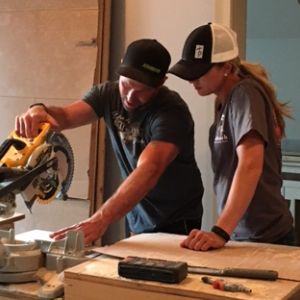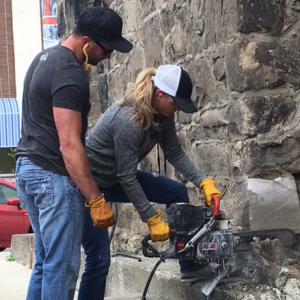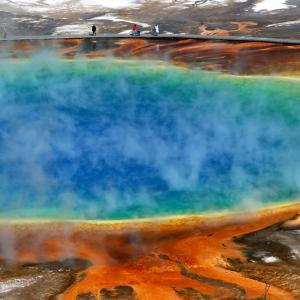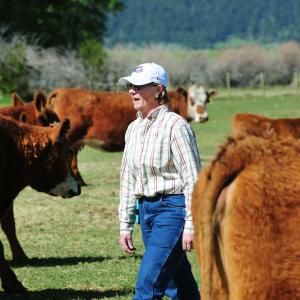On the Endecott Ranch near Ennis, cows are number one. From calving through weaning, and throughout the long, harsh winters in the Madison Valley, Janet Endecott’s Red Angus and Herefords receive the best of everything.
“We’re very particular about how we work our cows,” says Janet. “They come before everything else. We’ve got this operation set up so it works just right for the cows. In order to keep them happy and healthy, you need good land and water.”
The nexus for happy and healthy on Janet’s place is South Meadow Creek. Originating in the southern Tobacco Root Mountains, the stream meanders through the heart of the ranch’s main pastures. On days of extreme heat or bitter cold, native willow thickets – a rancher’s best friend, Janet says -- offer her cows shade or shelter from frigid winds; water from the creek irrigates the pastures; and at all times, there’s drinking water, the single most important nutrient for a cow.
They enjoyed a particular stretch of the creek, where they massed together, going in and out of the water to drink. Over many years their unimpeded activity had worn down the stream banks and made the stream channel broader and shallower. Their hooves churned up the stream bottom. They grazed all of the streamside vegetation, then grazed it again.
“We bring the cows on to this place to calve, and when you’ve got more than 200 cows watering in one area during the winter and spring, it can cause quite a bit of damage,” she says. “I knew something needed to be done, but I didn’t know exactly what that was.”
It was 2010, and Sunni Heikes-Knapton, Watershed Coordinator for the Madison Conservation District (MCD), was about to launch a new project on South Meadow Creek. With a grant from the Montana Department of Natural Resources and Conservation, the District would undertake an assessment of irrigation diversion structures on the stream.
“The creek often gets dewatered in summer,” Knapton says. “Some of the irrigation structures were primitive and highly inefficient. We thought if we could get new structures in a few places there might be a little more water in the stream.”
MCD also wanted to assess whether any irrigation structures impacted the stream’s natural functions. Knapton invited Pat Clancey, a fisheries biologist with Montana Fish, Wildlife & Parks, for a tour. Clancey identified several irrigation diversions, including the structure owned by Janet and her late husband, Bob, which prevented the resident brook and brown trout from moving upstream. “There was enough of a drop in water level on Janet’s diversion that only a few of the fish were large enough to get up and over it,” says Clancey.
He also assessed the creek as it meandered through Janet’s pasture. He saw the cows’ favorite watering spot, the wide and shallow stream bottom, the eroded banks, the sedimentation, the lack of streamside vegetation. Talking things over with Knapton, Clancey offered an idea: along with upgrading irrigation works, why not make some habitat improvements? “Around Janet’s place, those rich soils are more prone to impacts from livestock. But a site like that is also very recoverable,” Clancey says. “It was a great opportunity to turn the situation around.”
When Sunni Heikes-Knapton sat down with Janet and Bob Endecott to present her ideas for improving the stream, Janet’s initial response was, “You want to do WHAT?!”
The stream corridor would be fenced on each side, creating a long, narrow riparian pasture of about four acres. Janet’s two largest pastures would be configured, north and south of the creek. Her cows would no longer drink from the stream unless they were in the riparian pasture – and they would only be in that pasture for a very short time in the fall. Instead of getting water from the creek, the cows would use water tanks, situated away from the creek, one in each pasture.
Looking back on it, Janet says her initial response was fairly typical for any rancher. But she was also co-chair of the Madison Conservation District. She understood the need to lead by example. Even as she said yes, “I was thinking I would get nothing out of it besides the off-stream water. I would be the nice person who made the stream better. But I wouldn’t actually benefit that much.”
And there was one other thing: Janet knew Sunni. They worked together. They respected each other. Janet had a good measure of trust in Sunni. The plan would certainly change the way she managed her cows, and she didn’t know how it would turn out, but if Sunni believed the stream would see benefits, Janet was willing to give it a try.
The Madison CD developed a plan for funding the irrigation structure, as well as the water tanks, well and fencing. Through his work with PPL Montana and the company’s mitigation account, Pat Clancey assisted Heikes-Knapton in securing funds for the water tanks, well, pipeline, plumbing, fencing, and a hardened creek crossing. The well and water tanks were installed in November of 2011, the fencing in November of 2012.
The first spring after fencing, there were big changes along the creek.
“All these plants were coming in that I’d never seen before,” Janet says. There were different grasses, and forbs, and what looked like new shrubs. Janet had never seen them because her cows grazed off the new growth as soon as it emerged. As the growing season continued, the grass grew thick and lush. The plant community matured and produced seeds, further enriching itself. Under the new plan, Janet would put her cows in the streamside pasture just once, in November, for three to five days. It would be one heck of a banquet, if short-lived.
If Janet and Bob had reservations about the streamside pasture, they had even bigger concerns about the new watering system staying functional in the winter. The Madison Valley is well-known for its wind, and winter wind chill values can drop well below zero and stay there for days. Each day Janet kept a close watch on the water tanks. Once again, she was surprised by what she saw.
Cows in general don’t want to be too far from their water. Under the old program, that meant they were never very far from the creek. But with water available any time in the tanks – and the tanks located farther out in each pasture – the cows were more dispersed. They were grazing areas regularly that in the past were grazed inconsistently. Their pattern of water consumption changed, too. In the past, smaller or less-competitive cows wouldn’t get water as regularly because they weren’t as good at navigating the crowd along the creek; they’d grow tired of waiting, or get pushed back in the line; the creek would freeze over and they would move on. With the herd spread out and open water available at all times, access to water was easier.
“That has helped them nutritionally, especially in the really cold, nasty weather” Janet says. “There’s water any time they want, so they water more regularly.”
The tanks also eliminated some hard physical labor for Janet. In the dead of winter, she no longer had to visit the iced-up creek with a spud bar and chop out a space for her cows to safely get their water.
“I had huge reservations about the water tanks freezing up in the winter, but with a good design and help from Dan Durham with the Natural Resource Conservation Service, the off-stream water turned out to be a major improvement. It was exciting to see,” Janet says.
Without constant visits from the cows, South Meadow Creek is restoring itself. The wide, shallow streambed has begun to narrow and deepen, and the stream’s meanders are becoming more defined, creating pools where trout want to live. The steady increase in plant growth has stabilized the banks and halted erosion. After a couple of years, Janet was thrilled to see her best friend – willows – coming up in the creek bottom. They’d been there all along, trying to get a start, but the cows grazed them back. As the willows and other plants grow taller, fuller, they put more shade on the water, which helps to keep it cooler, another gain for the fishery.
Across Montana, Conservation Districts like the Madison CD work at the local level to promote and implement projects that benefit vital natural resources. The focus, says Sunni Heikes-Knapton, “is finding achievable goals – efforts that improve resources and help landowners succeed in their operations. We can help make change where there’s an opportunity. And it doesn’t have to be on a massive scale.”
One of the greatest assets for CDs is their grassroots organization. A conservation project on private land – and one requiring the landowner to alter the way they do things – depends upon trust. In a rural community, it’s far easier to trust someone you or your friends and neighbors know.
That trust is now expanding outwards. In 2015, Janet Endecott persuaded her brother to launch a similar project on nearby Moore’s Creek. A lot of Janet’s neighbors have stopped by to see her new pasture and watering system. “I can gently nudge people into thinking about a place where they could do a similar thing,” Janet says. “And I really stress it doesn’t have to be a huge project. If a lot of people each do one small thing to make the stream better where it flows through their place, it can make a huge difference.”
“This project happened because of the credibility that Sunni brought as a watershed coordinator and the mutual trust that developed between Sunni and Janet,” says Pat Clancey. “Developing that trust is the key to getting a project like this off the ground. The landowner has to be satisfied with how the project works for them. Having seen a number of these projects, it can be a hard sell because people are used to doing things the way they’ve always done them. But in just about every project I’ve seen, the outcomes have been positive for every interest – the landowner, the livestock, the fishery, the stream.”
Written by John Grassy, Montana Department of Natural Resources & Conservation, Public Information Officer, and photographer, Eliza Wiley.






